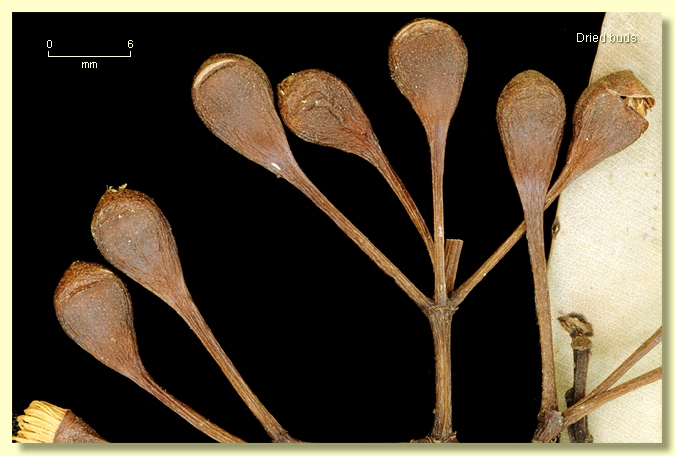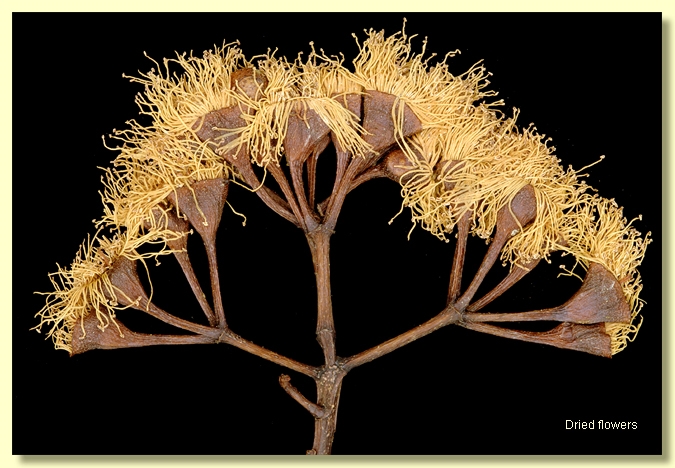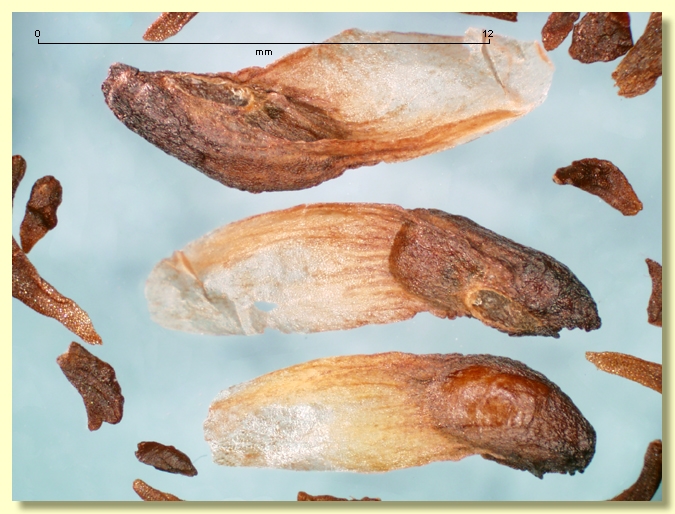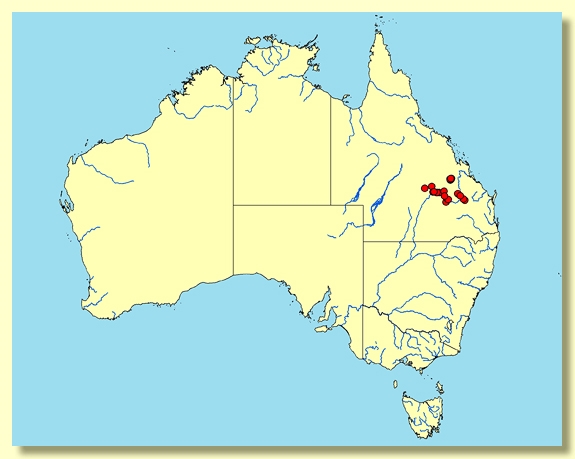Euclid - Online edition
Corymbia hendersonii
Corymbia | Rufaria
Corymbia hendersonii K.D.Hill & L.A.S.Johnson, Telopea 6: 279 (1995).
Tree to 25 m tall. Forming a lignotuber.
Bark rough over trunk and branches to ca 2 cm diameter, coarsely tessellated, grey to dark brown.
Branchlets smooth (glabrous); elongated oil bodies sometimes present in the pith.
Juvenile growth (coppice or field seedlings to 50 cm): stems rounded in cross-section, smooth (glabrous); juvenile leaves always shortly petiolate, opposite or becoming sub-opposite to alternate, linear-elliptic to narrowly lanceolate, 4.2–9.5 cm long, 0.7–2 cm wide, base tapering to petiole, apex pointed, green, discolorous, glabrous.
Adult leaves alternate, petioles 0.9–2.6 cm long; blade lanceolate, 7–17 cm long, 0.8–3(3.5) cm wide, base tapering to petiole, margin entire, apex finely pointed, strongly discolorous, usually glossy, dark green above, paler below, smooth, side-veins greater than 45° to midrib, reticulation dense to very dense, intramarginal vein present but very close to margin and more easily seen from underside, oil glands obscure or sparse, island.
Inflorescence terminal compound, peduncles slender 0.2–2 cm long, buds 7 per umbel, pedicels 0.3–1.9 cm long. Mature buds obovoid to ovoid, 0.8–1.2 cm long, 0.4–0.6 cm wide, smooth, scar absent (both opercula shed together at flowering), operculum shallowly rounded to conical or occasionally beaked, stamens inflexed, all fertile, anthers oblong, dorsifixed, versatile, dehiscing by longitudinal slits, style long and straight, stigma blunt, locules 4 or 5, the ovules not arranged in clear rows on the placentae. Flowers creamy white.
Fruit pedicellate (pedicels 0.2–1.7 cm long), urceolate to ± barrel-shaped, usually with a conspicuous neck and thickened rim, occasionally lacking the neck and simply tapering to the rim, (1.5)1.7–3.1 cm long, (1.2)1.4–2.2 cm wide, longer than wide, ± smooth, disc descending vertically, valves 4 or 5, enclosed.
Seeds brown, (7)9–15(17) mm long, ellipsoidal with terminal wing, hilum ventral.
Cultivated seedlings (measured at ca node 10): cotyledons reniform; stems rounded in cross-section, setose with short bristle-glands for lower 2 to 5 internodes, then glabrous; leaves shortly petiolate, opposite, linear-oblong to narrowly lanceolate, 8–12.5 cm long, 0.9–1.8 cm wide, base tapering to petiole, upper surface glabrous, dull, dark green, becoming glossy by node 10–11, sparsely setose only on paler lower surface of lowest leaves, soon becoming glabrous.
Flowering has been recorded in January, February and March.
A bloodwood tree endemic to central Queensland where it is found on ranges and tablelands from Blackdown Tableland south to Cracow and west to the general area of the Carnarvon Range, preferring sandstone sites with skeletal sandy soil. Corymbia hendersonii has grey chunky bloodwood bark except on the smallest branches, glossy crown leaves that are paler on the underside, smooth buds in compound inflorescences at the ends of the branchlets and ± urn-shaped fruit thickened at the rim.
C. hendersonii is one of four fully rough-barked bloodwood species with smooth (not scurfy) buds and discolorous leaves found growing in inland central Queensland. It is likely to be confused with C. brachycarpa, C. lamprophylla and C. clandestina.
C. hendersonii has larger and thicker-walled fruit (1.2–2.1 cm wide) than both C. brachycarpa (fruit 1–1.5 cm wide) and C. clandestina (0.7–1 cm wide), but with some slight overlap in dimensions. C. lamprophylla differs from C. hendersonii in having strikingly glossy adult leaves and slightly setose and glossy juvenile leaves (glabrous and ± dull in C. hendersonii) but with fruit of ± similar size. C. clarksoniana differs from C. hendersonii in having scurfy (not smooth) buds and fruit without the thickened rim. The coastal species C. xanthope differs from C. hendersonii in fruit and bark features (fruit 1–1.5 cm wide in C. xanthope cf. ((1.2)1.4–2.1 cm wide in C. hendersonii, and yellowish brown bark in the former, grey to dark brown bark in C. hendersonii).
C. plena is another bloodwood species with discolorous adult leaves and rough bark that also occurs in this area. It differs from C. hendersonii in having plump scurfy buds.
MORE ABOUT CORYMBIA
MORE ABOUT RED BLOODWOODS
Corymbia hendersonii: after Rodney J. Henderson (1938-extant 2009). Rod Henderson was botanist with the Queensland Herbarium for 41 years and retired in 2002.


















